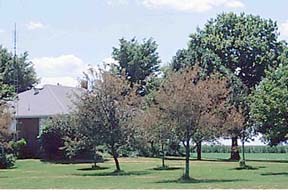Japanese Beetle Update and Hosts | |
|---|---|
| July 1, 2008 | |
|
Japanese beetle adults continue to be slow in emergence this year. We have reports of single beetles being found on June 21 and 23 in the Champaign-Urbana area. A similar emergence pattern is being seen in the Charleston area, with the first beetles being seen on June 23 and just a few beetles having emerged through the next few days. Higher numbers are being seen in the Salem area of southern Illinois; but they also just started to emerge around June 20, and their numbers are still building. We anticipate emergence to begin in northern Illinois during the week of July 6. When the adult Japanese beetles emerge, questions arise on host preference. Favored hosts of Japanese beetle adults include Japanese maple, gray birch, black walnut, American elm, London planetree, black cherry, American mountainash, pussy willow, Norway maple, horsechestnut, sassafras, shrub-althea, crabapple, rose, Lombardy poplar, and linden. They seem to prefer smartweed over any other plant. Many keep a watch on this weed to catch the first emergence of Japanese beetle. With the above list, it seems like there must be nothing that the beetles donít like. However, the list of least-favored plants is rather lengthy. Included are red maple, American holly, snowberry, flowering dogwood, yellow poplar, white ash, lilac, Scotch pine, Canadian hemlock, hydrangea, silver maple, boxwood, winged euonymous, white-cedar, saucer magnolia, green ash, Norway spruce, Douglas fir, mockorange, and yew. As a group, needled evergreens are rarely attacked. Many other trees and shrubs are intermediate in attractiveness. Trees such as buckeye, sugar maple, and oaks may sustain some damage but typically have only the uppermost and outermost areas of the canopy fed upon because Japanese beetles prefer sunlit leaves. Even heavily attacked trees and shrubs rarely exhibit severe dieback because the beetles attack after the bulk of food production has already occurred in the leaves. Photosynthetic production primarily occurs early in the season when the leaves are still soft and pliable. Spring pests such as gypsy moth are much more important to tree health because the leaves are eaten before they have even replaced the energy that the tree used to produce them. Three or more successive years of spring defoliation causes severe dieback and even death. Because Japanese beetle defoliation occurs later in the growing season, the damage is considered to be primarily aesthetic. This allows one to selectively treat those trees and shrubs in very obvious landscape locations and to ignore the damage on others. This reduces the amount of pesticide introduced into the environment and also reduces client costs. (Phil Nixon, Paul Switzer and Harold Hunzicker) | |
| Author: | Harold Hunzicker Phil Nixon |

